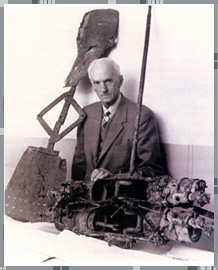
George Bolt with the relics he found
Pearse's achievements were even more remarkable in that, unlike the Wright Brothers who employed skilled engineers and who later enjoyed the luxury of American Government sponsorship, Pearse designed, financed, and built everything himself. And he did not even have access to a university or library, but gained his knowledge solely through reading the magazines that he subscribed to.
He was a great engineer and designer, and yet had no influence whatsoever on the course of history. Yet we can admire his inventiveness, ingenuity and pure achievement against huge odds - lack of resources, isolation, and ridicule by those who lived around him.
He was a misfit in his community - a farming community where if you couldn't farm, you were an idiot. Yet he wanted to fly.
The tragic irony of Pearse's life is that his pioneering and ingenious innovations were never recognised in his lifetime, or else they were developed and surpassed elsewhere.